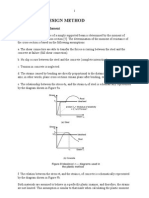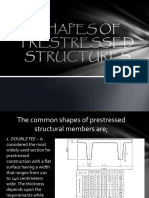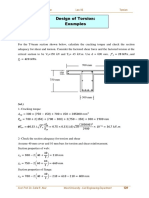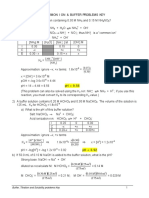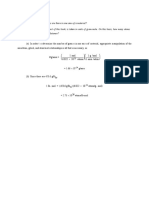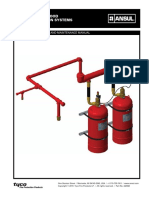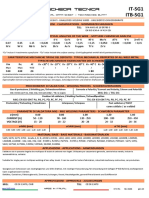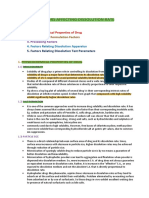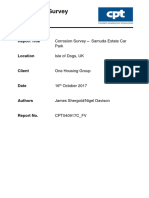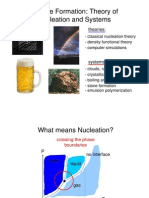0 ratings0% found this document useful (0 votes)
316 viewsTorsion Problems
Torsion Problems
Uploaded by
Louie G Navalta1. This document contains 30 problems related to determining stresses, strains, and dimensions of mechanical components like shafts and rods under various torque and load conditions. The problems involve calculating shear and tensile stresses, angles of twist, and required diameters or cross-sectional areas using material properties like shear and tensile strength limits and modulus of rigidity.
Copyright:
© All Rights Reserved
Available Formats
Download as DOCX, PDF, TXT or read online from Scribd
Torsion Problems
Torsion Problems
Uploaded by
Louie G Navalta0 ratings0% found this document useful (0 votes)
316 views7 pages1. This document contains 30 problems related to determining stresses, strains, and dimensions of mechanical components like shafts and rods under various torque and load conditions. The problems involve calculating shear and tensile stresses, angles of twist, and required diameters or cross-sectional areas using material properties like shear and tensile strength limits and modulus of rigidity.
Original Description:
torsion problems from mathalino
Copyright
© © All Rights Reserved
Available Formats
DOCX, PDF, TXT or read online from Scribd
Share this document
Did you find this document useful?
Is this content inappropriate?
1. This document contains 30 problems related to determining stresses, strains, and dimensions of mechanical components like shafts and rods under various torque and load conditions. The problems involve calculating shear and tensile stresses, angles of twist, and required diameters or cross-sectional areas using material properties like shear and tensile strength limits and modulus of rigidity.
Copyright:
© All Rights Reserved
Available Formats
Download as DOCX, PDF, TXT or read online from Scribd
Download as docx, pdf, or txt
0 ratings0% found this document useful (0 votes)
316 views7 pagesTorsion Problems
Torsion Problems
Uploaded by
Louie G Navalta1. This document contains 30 problems related to determining stresses, strains, and dimensions of mechanical components like shafts and rods under various torque and load conditions. The problems involve calculating shear and tensile stresses, angles of twist, and required diameters or cross-sectional areas using material properties like shear and tensile strength limits and modulus of rigidity.
Copyright:
© All Rights Reserved
Available Formats
Download as DOCX, PDF, TXT or read online from Scribd
Download as docx, pdf, or txt
You are on page 1of 7
1. A steel shaft 3 ft long that has relative to gear A.
a diameter of 4 in is subjected
to a torque of 15 kip·ft.
Determine the maximum shearing
stress and the angle of twist.
Use G = 12 × 106psi.
2. What is the minimum diameter of a
solid steel shaft that will not
twist through more than 3° in a
6-m length when subjected to a
torque of 12 kN·m? What maximum 9. A flexible shaft consists of a
shearing stress is developed? Use 0.20-in-diameter steel wire
G = 83 GPa. encased in a stationary tube that
fits closely enough to impose a
3. A steel marine propeller shaft 14 frictional torque of 0.50
in. in diameter and 18 ft long is lb·in/in. Determine the maximum
used to transmit 5000 hp at 189 length of the shaft if the
rpm. If G = 12 × 106 psi, shearing stress is not to exceed
determine the maximum shearing 20 ksi. What will be the angular
stress. deformation of one end relative
to the other end? G = 12 ×
4. A solid steel shaft 5 m long is 106 psi.
stressed at 80 MPa when twisted
through 4°. Using G = 83 GPa, 10. Determine the maximum torque
compute the shaft diameter. What that can be applied to a hollow
power can be transmitted by the circular steel shaft of 100-mm
shaft at 20 Hz? outside diameter and an 80-mm
inside diameter without exceeding
5. A 2-in-diameter steel shaft a shearing stress of 60 MPa or a
rotates at 240 rpm. If the twist of 0.5 deg/m. Use G = 83
shearing stress is limited to 12 GPa.
ksi, determine the maximum
horsepower that can be 11. The steel shaft shown in Fig.
transmitted. P-314 rotates at 4 Hz with 35 kW
taken off at A, 20 kW removed at
6. A steel propeller shaft is to B, and 55 kW applied at C. Using
transmit 4.5 MW at 3 Hz without G = 83 GPa, find the maximum
exceeding a shearing stress of 50 shearing stress and the angle of
MPa or twisting through more than rotation of gear A relative to
1° in a length of 26 diameters. gear C.
Compute the proper diameter if G
= 83 GPa.
7. Show that the hollow circular
shaft whose inner diameter is
half the outer diameter has a
torsional strength equal to 15/16 12. A 5-m steel shaft rotating at
of that of a solid shaft of the 2 Hz has 70 kW applied at a gear
same outside diameter. that is 2 m from the left end
8. An aluminum shaft with a constant where 20 kW are removed. At the
diameter of 50 mm is loaded by right end, 30 kW are removed and
torques applied to gears attached another 20 kW leaves the shaft at
to it as shown in Fig. P-311. 1.5 m from the right end. (a)
Using G = 28 GPa, determine the Find the uniform shaft diameter
relative angle of twist of gear D so that the shearing stress will
not exceed 60 MPa. (b) If a
uniform shaft diameter of 100 mm is 50 mm, τ ≤ 80 MPa, and G = 83
is specified, determine the angle GPa. If a = 2 m and b = 1.5 m,
by which one end of the shaft compute the maximum torque T
lags behind the other end. Use G that can be applied.
= 83 GPa.
13. A compound shaft consisting of
a steel segment and an aluminum
segment is acted upon by two
torques as shown in Fig. P-316.
Determine the maximum permissible
value of T subject to the
following conditions: τst ≤ 83
MPa, τal ≤ 55 MPa, and the angle
of rotation of the free end is 17. In Prob. 16, determine the ratio
limited to 6°. For steel, G = 83 of lengths b/a so that each
GPa and for aluminum, G = 28 GPa. material will be stressed to its
permissible limit. What torque T
14. A hollow bronze shaft of 3 in. is required?
outer diameter and 2 in. inner 18. A solid steel shaft is loaded as
diameter is slipped over a solid shown in Fig. P-322. Using G =
steel shaft 2 in. in diameter and
83 GPa, determine the required
of the same length as the hollow
diameter of the shaft if the
shaft. The two shafts are then
fastened rigidly together at shearing stress is limited to 60
their ends. For bronze, G = 6 × MPa and the angle of rotation at
106psi, and for steel, G = 12 × the free end is not to exceed 4
106 psi. What torque can be deg.
applied to the composite shaft
without exceeding a shearing
stress of 8000 psi in the bronze
or 12 ksi in the steel?
15. A solid aluminum shaft 2 in.
in diameter is subjected to two
torques as shown in Fig. P-318.
Determine the maximum shearing
stress in each segment and the
angle of rotation of the free 19. A shaft composed of segments AC,
end. Use G = 4 × 106 psi. CD, and DB is fastened to rigid
supports and loaded as shown
in Fig. P-323. For bronze, G =
35 GPa; aluminum, G = 28 GPa,
and for steel, G = 83 GPa.
Determine the maximum shearing
stress developed in each
segment.
16. The compound shaft shown in Fig.
P-319 is attached to rigid
supports. For the bronze segment
AB, the diameter is 75 mm, τ ≤
60 MPa, and G = 35 GPa. For the
steel segment BC, the diameter
20. The compound shaft shown in Fig. of the tube if the stress is
P-324 is attached to rigid limited to 120 MN/m2.
supports. For the bronze segment
AB, the maximum shearing stress 23. A homogeneous 800 kg bar AB is
is limited to 8000 psi and for supported at either end by a
the steel segment BC, it is cable as shown in Fig. P-105.
limited to 12 ksi. Determine the Calculate the smallest area of
diameters of each segment so each cable if the stress is not
that each material will be to exceed 90 MPa in bronze and
simultaneously stressed to its 120 MPa in steel.
permissible limit when a torque
T = 12 kip·ft is applied. For
bronze, G = 6 × 106 psi and for
steel, G = 12 × 106psi.
24. The homogeneous bar shown in
21. The two steel shaft shown in Fig. P-106 is supported by a
Fig. P-325, each with one end smooth pin at C and a cable that
built into a rigid support have runs from A to B around the
flanges rigidly attached to smooth peg at D. Find the stress
their free ends. The shafts are in the cable if its diameter is
to be bolted together at their 0.6 inch and the bar weighs 6000
flanges. However, initially lb.
there is a 6° mismatch in the
location of the bolt holes as
shown in the figure. Determine
the maximum shearing stress in
each shaft after the shafts are
bolted together. Use G = 12 ×
106 psi and neglect deformations
of the bolts and flanges.
25. A rod is composed of an aluminum
section rigidly attached between
steel and bronze sections, as
shown in Fig. P-107. Axial loads
are applied at the positions
indicated. If P = 3000 lb and
the cross sectional area of the
rod is 0.5 in2, determine the
stress in each section.
22. A hollow steel tube with an
inside diameter of 100 mm must
carry a tensile load of 400 kN.
Determine the outside diameter
1800 psi and that in concrete to
650 psi.
26. An aluminum rod is rigidly
attached between a steel rod and
a bronze rod as shown in Fig. P-
29. For the truss shown in Fig. P-
108. Axial loads are applied at
111, calculate the stresses in
the positions indicated. Find
members CE, DE, and DF. The
the maximum value of P that will
cross-sectional area of each
not exceed a stress in steel of
member is 1.8 in2. Indicate
140 MPa, in aluminum of 90 MPa,
tension (T) or compression (C)
or in bronze of 100 MPa.
30. Determine the cross-sectional
areas of members AG, BC, and CE
27. Determine the largest weight W for the truss shown in Fig. P-
that can be supported by two 112. The stresses are not to
wires shown in Fig. P-109. The exceed 20 ksi in tension and 14
stress in either wire is not to ksi in compression. A reduced
exceed 30 ksi. The cross- stress in compression is
sectional areas of wires AB and specified to reduce the danger
AC are 0.4 in2 and 0.5 in2, of buckling.
respectively.
28. A 12-inches square steel bearing
plate lies between an 8-inches
diameter wooden post and a
concrete footing as shown in
Fig. P-110. Determine the
maximum value of the load P if
the stress in wood is limited to
31. Find the stresses in members BC, If the plate is 0.25 inch thick,
BD, and CF for the truss shown determine the diameter of the
in Fig. P-113. Indicate the smallest hole that can be
tension or compression. The punched.
cross sectional area of each
member is 1600 mm2.
35. Find the smallest diameter bolt
that can be used in the clevis
shown in Fig. 1-11b if P = 400
kN. The shearing strength of the
bolt is 300 MPa.
32. The homogeneous bar ABCD shown
in Fig. P-114 is supported by a
cable that runs from A to B
around the smooth peg at E, a
vertical cable at C, and a
smooth inclined surface at D.
Determine the mass of the
heaviest bar that can be
supported if the stress in each
cable is limited to 100 MPa. The 36. A 200-mm-diameter pulley is
area of the cable AB is 250 prevented from rotating relative
mm2 and that of the cable at C to 60-mm-diameter shaft by a 70-
is 300 mm2. mm-long key, as shown in Fig. P-
118. If a torque T = 2.2 kN·m is
applied to the shaft, determine
the width b if the allowable
shearing stress in the key is 60
MPa.
33. What force is required to punch
a 20-mm-diameter hole in a plate
that is 25 mm thick? The shear
strength is 350 MN/m2.
34. As in Fig. 1-11c, a hole is to
be punched out of a plate having
a shearing strength of 40 ksi. 37. Compute the shearing stress in
The compressive stress in the the pin at B for the member
punch is limited to 50 ksi. (a) supported as shown in Fig. P-
Compute the maximum thickness of 119. The pin diameter is 20 mm.
plate in which a hole 2.5 inches
in diameter can be punched. (b)
the axial force P that can be
safely applied to the block if
the compressive stress in wood
is limited to 20 MN/m2and the
shearing stress parallel to the
grain is limited to 5MN/m2. The
grain makes an angle of 20° with
the horizontal, as shown. (Hint:
Use the results in Problem 122.)
38. The members of the structure in
Fig. P-120 weigh 200 lb/ft.
Determine the smallest diameter
pin that can be used at A if the
shearing stress is limited to
5000 psi. Assume single shear.
41. In Fig. 1-12, assume that a 20-
mm-diameter rivet joins the
plates that are each 110 mm
wide. The allowable stresses are
120 MPa for bearing in the plate
material and 60 MPa for shearing
of rivet. Determine (a) the
minimum thickness of each plate;
39. Referring to Fig. P-121, compute and (b) the largest average
the maximum force P that can be tensile stress in the plates.
applied by the machine operator,
if the shearing stress in the
pin at B and the axial stress in
the control rod at C are limited
to 4000 psi and 5000 psi,
respectively. The diameters are
0.25 inch for the pin, and 0.5
inch for the control rod. Assume
single shear for the pin at B.
42. The lap joint shown in Fig. P-
126 is fastened by four ¾-in.-
diameter rivets. Calculate the
maximum safe load P that can be
applied if the shearing stress
in the rivets is limited to 14
ksi and the bearing stress in
40. A rectangular piece of wood, 50 the plates is limited to 18 ksi.
mm by 100 mm in cross section, Assume the applied load is
is used as a compression block uniformly distributed among the
shown in Fig. P-123. Determine four rivets.
You might also like
- Spreadsheet For Design of Bridge BearingsDocument8 pagesSpreadsheet For Design of Bridge BearingsAli Akbar100% (1)
- Cyl Breaks1 PDFDocument2 pagesCyl Breaks1 PDFHussein BeqaiNo ratings yet
- E.N.G.I.N.E.E.R., Inc.: Basic Mepf Design For Mix-Use BuildingsDocument83 pagesE.N.G.I.N.E.E.R., Inc.: Basic Mepf Design For Mix-Use BuildingsGerlie DimayugaNo ratings yet
- CO1 HaysDocument4 pagesCO1 Hayso100% (1)
- Strength of Materials 4th Ed by Ferdinand L Singer Andrew Pytel Www07MettkDocument21 pagesStrength of Materials 4th Ed by Ferdinand L Singer Andrew Pytel Www07Mettkvjereme100% (4)
- B370Document4 pagesB370phuongqcNo ratings yet
- Ce Laws - Section1.ppsxDocument27 pagesCe Laws - Section1.ppsxniel paulNo ratings yet
- Module 002 CE ELECT 5S-Structural Framing Concepts and Preliminary SizingDocument13 pagesModule 002 CE ELECT 5S-Structural Framing Concepts and Preliminary SizingCeasar MerialesNo ratings yet
- Stresses in Soil Mass Problem 1: Foundation Engineering 1Document3 pagesStresses in Soil Mass Problem 1: Foundation Engineering 1Kristin ArgosinoNo ratings yet
- Quiz 1lecture Ce3Document46 pagesQuiz 1lecture Ce3FELICITY MONTEFALCONo ratings yet
- Beams and Other Flexural Members PDFDocument52 pagesBeams and Other Flexural Members PDFJeyjay BarnuevoNo ratings yet
- Seismic Forces - Simplified Static Force Method and Static Force MethodDocument13 pagesSeismic Forces - Simplified Static Force Method and Static Force MethodJaid HedrianaNo ratings yet
- Vibration Serviceability of Long-Span Concrete BuiDocument82 pagesVibration Serviceability of Long-Span Concrete BuiDaniel A. FlorêncioNo ratings yet
- PP02B - Asep - NSCP 2015 Update On Appendix 1-BDocument10 pagesPP02B - Asep - NSCP 2015 Update On Appendix 1-BjimNo ratings yet
- RCD - Interaction Diagram & Long Column: ExampleDocument8 pagesRCD - Interaction Diagram & Long Column: ExampleAurora VillalunaNo ratings yet
- Compression Members PDFDocument20 pagesCompression Members PDFMichael ReyesNo ratings yet
- Series Resistive and Parallel Resistive Circuits: Experiment 3Document19 pagesSeries Resistive and Parallel Resistive Circuits: Experiment 3Illion IllionNo ratings yet
- TP04 Flores PDFDocument11 pagesTP04 Flores PDFJefreyMatuanMondranoNo ratings yet
- EARTHQUAKE RECORDS AND MEASURING INSTRUMENT. Seismograph. Accelograph. Seismoscope. Earthquake Networks. Design of An Improvised SeismographDocument22 pagesEARTHQUAKE RECORDS AND MEASURING INSTRUMENT. Seismograph. Accelograph. Seismoscope. Earthquake Networks. Design of An Improvised SeismographJeffry VargasNo ratings yet
- Pool AnalysisDocument38 pagesPool AnalysissubhanNo ratings yet
- Timber and Steel DesignDocument47 pagesTimber and Steel DesignJane RegaladoNo ratings yet
- Errata For ACI 318-14 1st PrintingDocument9 pagesErrata For ACI 318-14 1st PrintingKikoCanNo ratings yet
- Title of The Module: Reinforced Concrete Design Module 12 Subject: CE 74A-Reinforced Concrete DesignDocument15 pagesTitle of The Module: Reinforced Concrete Design Module 12 Subject: CE 74A-Reinforced Concrete DesignJemson VictorioNo ratings yet
- 9 - Flanged Bolt CouplingDocument15 pages9 - Flanged Bolt CouplingPatrick Antonio Orge ChingNo ratings yet
- Introduction On Principles of Steel DesignDocument9 pagesIntroduction On Principles of Steel DesignMaria Therese PrietoNo ratings yet
- Chapter 1 - Introduction To SeismologyDocument20 pagesChapter 1 - Introduction To SeismologyKatherine Shayne YeeNo ratings yet
- Case Study Valdivia ChileDocument7 pagesCase Study Valdivia ChileJanah SabornidoNo ratings yet
- RRL ThesisDocument9 pagesRRL ThesisClint SechicoNo ratings yet
- Plastic Design MethodDocument8 pagesPlastic Design MethodBhaskar ReddyNo ratings yet
- Purlin DesignDocument4 pagesPurlin DesignIfkar AzmiNo ratings yet
- Module 4. Lesson 1 Earthquake-Load-CombinationsDocument9 pagesModule 4. Lesson 1 Earthquake-Load-CombinationsRich Lenard L. MagbooNo ratings yet
- TP19 Adiaz PDFDocument11 pagesTP19 Adiaz PDFJefreyMatuanMondranoNo ratings yet
- Timber Design ModuleDocument6 pagesTimber Design Modulemark jefferson castroNo ratings yet
- EVALUATION EXAM RCD Steel Design 1 QuestionnaireDocument7 pagesEVALUATION EXAM RCD Steel Design 1 QuestionnaireGaming PalonNo ratings yet
- RCD Lesson 5 T BeamsDocument15 pagesRCD Lesson 5 T BeamsChan MirandaNo ratings yet
- Research On Cocowood - SampleDocument9 pagesResearch On Cocowood - Samplejun del rosarioNo ratings yet
- Module 2Document2 pagesModule 2Jessen DañoNo ratings yet
- Cie-117-Rsw No.4-Bascos-FrancisDocument35 pagesCie-117-Rsw No.4-Bascos-FrancisFrancis BascosNo ratings yet
- Properties of Concrete With Coconut Husk and Dried Banana Leaffibers As Aggregate ReplacementintroductionrationaleDocument3 pagesProperties of Concrete With Coconut Husk and Dried Banana Leaffibers As Aggregate Replacementintroductionrationalejohn philip s garciaNo ratings yet
- Updates On Chapter 2: Minimum Design Loads: National Structural Code of The Philippines NSCP 2015, Volume 1Document52 pagesUpdates On Chapter 2: Minimum Design Loads: National Structural Code of The Philippines NSCP 2015, Volume 1Oreo CreamNo ratings yet
- TP20 Morales PDFDocument10 pagesTP20 Morales PDFJefreyMatuanMondranoNo ratings yet
- 1 - Introduction To Structural Steel Design-Chapter 1Document3 pages1 - Introduction To Structural Steel Design-Chapter 1Abera Deressa0% (1)
- Plate 1 - PCD - Del Rosario, LeonardDocument7 pagesPlate 1 - PCD - Del Rosario, LeonardLEONARD DEL ROSARIONo ratings yet
- Preliminary Sizing: Panel L, M L, M L /L Slab Design Min.h, M Min.h, MMDocument23 pagesPreliminary Sizing: Panel L, M L, M L /L Slab Design Min.h, M Min.h, MMTrol O'lolNo ratings yet
- Shapes of Pre Stressed StructuresDocument16 pagesShapes of Pre Stressed StructuresDennis Dale100% (2)
- FINAL-THESIS EditedDocument46 pagesFINAL-THESIS EditedRhea MambaNo ratings yet
- The 1964 Niigata EarthquakeDocument5 pagesThe 1964 Niigata EarthquakeAnghela SarnoNo ratings yet
- Thesis ManuscriptDocument177 pagesThesis ManuscriptMaevin WooNo ratings yet
- Lec 16-TorsionDocument10 pagesLec 16-Torsionjessa marie sayconNo ratings yet
- Review - Structural Engineering and Construction: C 3 S 3 A C yDocument2 pagesReview - Structural Engineering and Construction: C 3 S 3 A C ymichael SonuganNo ratings yet
- Orticio - Bs 3a-Reaction PaperDocument2 pagesOrticio - Bs 3a-Reaction PaperJewel Divina OrticioNo ratings yet
- Module 6 - Determinancy and StabilityDocument20 pagesModule 6 - Determinancy and StabilityPeter Harold MaducdocNo ratings yet
- Second Floor Beam Design CalculationDocument13 pagesSecond Floor Beam Design CalculationArnold VercelesNo ratings yet
- The NSCP 2015 Provisions On The Use of QT TMT Reinforcing Bars ISSEPDocument17 pagesThe NSCP 2015 Provisions On The Use of QT TMT Reinforcing Bars ISSEPMikchie Aquino TamayoNo ratings yet
- PSC Beam Analysis-AFM (Complete)Document66 pagesPSC Beam Analysis-AFM (Complete)NADEEM IQBALNo ratings yet
- Reinforced Concrete Beam: Location of D' & DTDocument6 pagesReinforced Concrete Beam: Location of D' & DTJheo TorresNo ratings yet
- FfghnvdzcklkuytfrdsxcvbnmDocument1 pageFfghnvdzcklkuytfrdsxcvbnmxxxxchrjycNo ratings yet
- 7-1 (Combined Bending and Axial Load)Document10 pages7-1 (Combined Bending and Axial Load)Johann TrujilloNo ratings yet
- MyNotes Column BreslerEquationDocument5 pagesMyNotes Column BreslerEquationGladies Mhay Binay SandovalNo ratings yet
- Assignment#3 (TRUSS)Document4 pagesAssignment#3 (TRUSS)subhashNo ratings yet
- SOM Axial Deformation.Document24 pagesSOM Axial Deformation.yas22e5019No ratings yet
- Draft of PresentationDocument2 pagesDraft of PresentationLouie G NavaltaNo ratings yet
- Rice Bran Constituents - Immunomodulatory and Therapeutic Activities.Document9 pagesRice Bran Constituents - Immunomodulatory and Therapeutic Activities.Louie G NavaltaNo ratings yet
- Purposive CommunicationDocument28 pagesPurposive CommunicationLouie G NavaltaNo ratings yet
- Standard Electrode Potentials in Aqueous Solution at 25°C: TablesDocument2 pagesStandard Electrode Potentials in Aqueous Solution at 25°C: TablesLouie G NavaltaNo ratings yet
- Combustion of Gaseous and Liquid FuelsDocument2 pagesCombustion of Gaseous and Liquid FuelsLouie G Navalta0% (1)
- Chemical CalculationsDocument6 pagesChemical CalculationsLouie G NavaltaNo ratings yet
- Case StudyDocument7 pagesCase StudyLouie G NavaltaNo ratings yet
- ProblemsDocument12 pagesProblemsLouie G NavaltaNo ratings yet
- Che 323 Problem Set 6: Electrochemistry March 12, 2014 Engr. May V. Tampus ConceptsDocument1 pageChe 323 Problem Set 6: Electrochemistry March 12, 2014 Engr. May V. Tampus ConceptsLouie G NavaltaNo ratings yet
- Annual Energy OutlookDocument256 pagesAnnual Energy OutlookLouie G Navalta100% (1)
- Problem SetsDocument7 pagesProblem SetsLouie G NavaltaNo ratings yet
- Answer To Probset 1Document12 pagesAnswer To Probset 1Louie G NavaltaNo ratings yet
- ChE 413N Problem Set 1 - Atomic Structure-Ionic Arrangements 4-20-16vstudDocument1 pageChE 413N Problem Set 1 - Atomic Structure-Ionic Arrangements 4-20-16vstudLouie G NavaltaNo ratings yet
- Acids Bases BuffersDocument10 pagesAcids Bases BuffersLouie G NavaltaNo ratings yet
- Utilization of Coconut Milk Skim Effluent (CSME) As Medium Growth For SpirulinaDocument5 pagesUtilization of Coconut Milk Skim Effluent (CSME) As Medium Growth For SpirulinaLouie G NavaltaNo ratings yet
- Carl John Louie Navalta Von Adrian Raboy Che 522 N Exercise December 4, 2017Document2 pagesCarl John Louie Navalta Von Adrian Raboy Che 522 N Exercise December 4, 2017Louie G NavaltaNo ratings yet
- Mass Balance Draft CHE 514N FORM-1-4-Calculation Sheets TemplateDocument8 pagesMass Balance Draft CHE 514N FORM-1-4-Calculation Sheets TemplateLouie G NavaltaNo ratings yet
- Pharmacist Job ResponsibilitiesDocument2 pagesPharmacist Job ResponsibilitiesLouie G NavaltaNo ratings yet
- Manual de FM200 - ANSUL (DESPROTEGIDO)Document170 pagesManual de FM200 - ANSUL (DESPROTEGIDO)ulises ranses pillaca ugarte0% (1)
- NBT 492Document4 pagesNBT 492Raja Qammar0% (1)
- Scheda Tecnica: IT-SG1 Itb-Sg1Document1 pageScheda Tecnica: IT-SG1 Itb-Sg1ITALFIL S.p.A.No ratings yet
- Product Datasheet - AvimasticDocument2 pagesProduct Datasheet - AvimasticZafer ÜlküNo ratings yet
- Introduction To Solutions WS Part I - VocabularyDocument2 pagesIntroduction To Solutions WS Part I - VocabularyCatherine JeaneNo ratings yet
- 0 Material Safety Data Sheet: Phenol MSDSDocument5 pages0 Material Safety Data Sheet: Phenol MSDSgarnielNo ratings yet
- جودة اللحام-searchableDocument58 pagesجودة اللحام-searchableHassan ElmasriNo ratings yet
- Productivity Rate & EstimatesDocument71 pagesProductivity Rate & EstimatesAlbert LuckyNo ratings yet
- Drilling Course Introduction To CementingDocument14 pagesDrilling Course Introduction To CementingEslam Ismaeel100% (1)
- Clay MineralsDocument16 pagesClay MineralsIatan Eugen Mihai100% (1)
- Labs-2 METAL FORMING Practice PDFDocument6 pagesLabs-2 METAL FORMING Practice PDFROYALNEWSSNo ratings yet
- PCC Tow Wall Type 1 - Height 0.8mDocument6 pagesPCC Tow Wall Type 1 - Height 0.8mPrabha KaranNo ratings yet
- Understanding Calcium Sulfonate ThickenersDocument3 pagesUnderstanding Calcium Sulfonate ThickenersAlejandro José Poveda GuevaraNo ratings yet
- Student Orientation: Chem 114: Chemistry For ENGINEERS (Laboratory)Document21 pagesStudent Orientation: Chem 114: Chemistry For ENGINEERS (Laboratory)Nora BuanNo ratings yet
- Factors Affecting Dissolution RateDocument7 pagesFactors Affecting Dissolution RateJubayer Al MahmudNo ratings yet
- Samuda Estate Underground Garages - Condition Survey - February 2018Document68 pagesSamuda Estate Underground Garages - Condition Survey - February 20187rph8yfr8vNo ratings yet
- Synthesis of Silver Nanoparticles With Different Shapes: Arabian Journal of ChemistryDocument16 pagesSynthesis of Silver Nanoparticles With Different Shapes: Arabian Journal of ChemistryMinhNo ratings yet
- Sika Retarder-22Document3 pagesSika Retarder-22Faouz BadoudNo ratings yet
- NCERT Solutions For Class 10th Science: Chapter 1 Chemical Reactions and EquationsDocument7 pagesNCERT Solutions For Class 10th Science: Chapter 1 Chemical Reactions and EquationsAnand MishraNo ratings yet
- Developmnet 10 - 2 - 3Document8 pagesDevelopmnet 10 - 2 - 3Garry SandhuNo ratings yet
- Airduc - Pur-Inox 355 Mhf-As enDocument3 pagesAirduc - Pur-Inox 355 Mhf-As enhojo coNo ratings yet
- Duct MaterialDocument3 pagesDuct MaterialJan Marvin TamseNo ratings yet
- Power Plant EngineeringDocument74 pagesPower Plant EngineeringPranesh Ka100% (1)
- Pavement Design1Document57 pagesPavement Design1Mobin AhmadNo ratings yet
- n2gb NMDocument6 pagesn2gb NMJulian ValherNo ratings yet
- Classical Nucleation TheoryDocument41 pagesClassical Nucleation Theoryswetavag100% (1)
- Ethylene Dichloride (Edc) / Vinyl Chloride Monomer (VCM) : Customer Process BrochureDocument4 pagesEthylene Dichloride (Edc) / Vinyl Chloride Monomer (VCM) : Customer Process Brochurerkapoor584199No ratings yet
- 2017716154112bitumen 6070Document1 page2017716154112bitumen 6070lab copriNo ratings yet




























